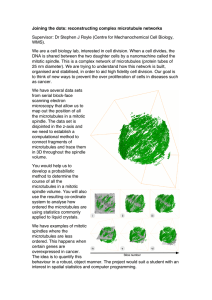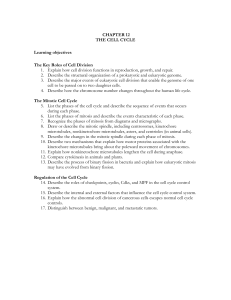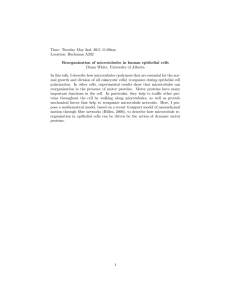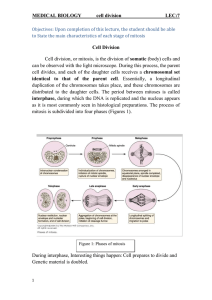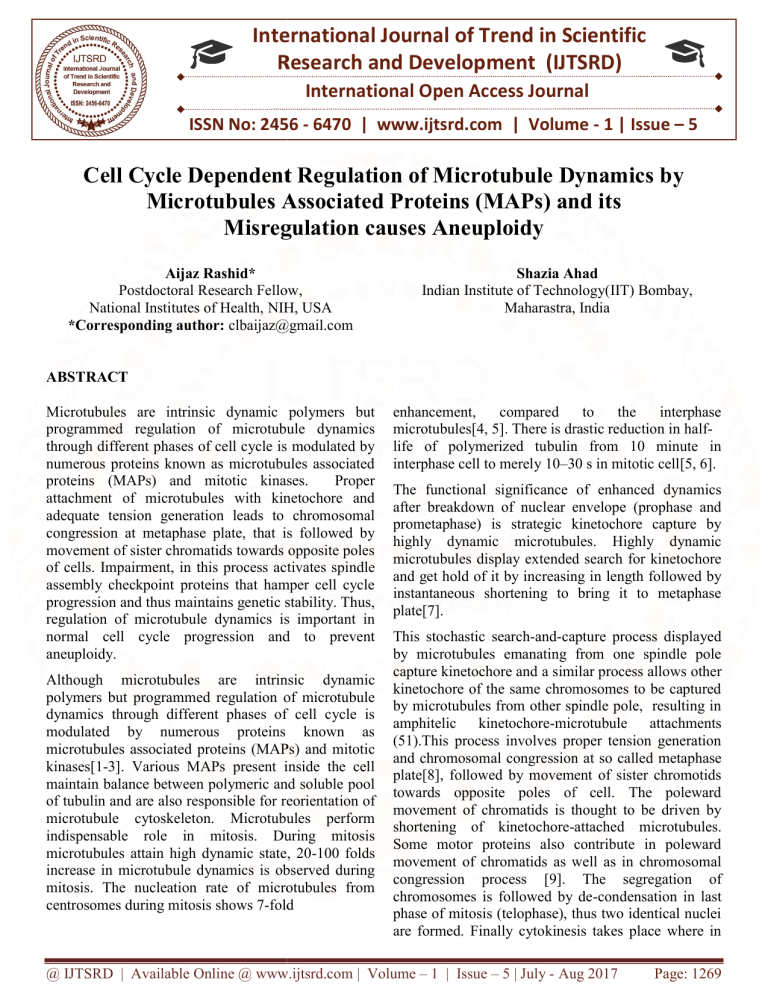
International Journal of Trend in Scientific
Research and Development (IJTSRD)
International Open Access Journal
ISSN No: 2456 - 6470 | www.ijtsrd.com | Volume - 1 | Issue – 5
Cell Cycle Dependent Regulation of Microtubule Dynamics by
b
Microtubules
tubules Associated Proteins (MAPs) and its
i
Misregulation
egulation causes Aneuploidy
Aijaz Rashid*
Postdoctoral Research
esearch Fellow
Fellow,
National Institutes of Health, NIH, USA
*Corresponding author: clbaijaz@gmail.com
Shazia Ahad
Indian Institute of Technology(IIT)
Technology(
Bombay,
Maharastra, India
ABSTRACT
Microtubules are intrinsic dynamic polymers but
programmed regulation of microtubule dynamics
through different phases of cell cycle is modulated by
numerous proteins known as microtubules associated
proteins (MAPs) and mitotic kinases.
Proper
attachment of microtubules with kinetochore and
adequate tension generation leads to chromosomal
congression at metaphase plate, that is followed by
movement of sister chromatids towards opposite poles
of cells. Impairment,
nt, in this process activates spindle
assembly checkpoint proteins that hamper cell cycle
progression and thus maintains genetic stability. Thus,
regulation of microtubule dynamics is important in
normal cell cycle progression and to prevent
aneuploidy.
Although
lthough microtubules are intrinsic dynamic
polymers but programmed regulation of microtubule
dynamics through different phases of cell cycle is
modulated by numerous proteins known as
microtubules associated proteins (MAPs) and mitotic
kinases[1-3].. Various MAPs present inside the cell
maintain balance between polymeric and soluble pool
of tubulin and are also responsible for reorientat
reorientation of
microtubule cytoskeleton. Microtubules perform
indispensable role in mitosis. During mitosis
microtubules attain high dynamic state, 20
20-100 folds
increase in microtubule dynamics is observed during
mitosis. The nucleation rate of microtubules from
centrosomes during mitosis shows 7-fold
fold
enhancement,
compared
to
the
interphase
microtubules[4, 5].. There is drastic reduction in halflife of polymerized tubulin from 10 minute in
interphase cell to merely 10–30
30 s in mitotic cell[5,
cell 6].
The functional significance of enhanced dynamics
after breakdown of nuclear envelope (prophase and
prometaphase) is strategic kinetochore capture by
highly dynamic microtubules. Highly dynamic
microtubules display extended
ended search for kinetochore
and get hold of it by increasing in length followed by
instantaneous shortening to bring it to metaphase
plate[7].
This stochastic search-and-capture
capture process displayed
by microtubules emanating from one spindle pole
capture kinetochore and a similar
imilar process allows other
kinetochore of the same chromosomes to be captured
by microtubules from other spindle pole, resulting in
amphitelic kinetochore-microtubule
microtubule attachments
(51).This process involves proper tension generation
and chromosomal congression
ssion at so called metaphase
plate[8],, followed by movement of sister chromotids
towards opposite poles of cell. The poleward
movement of chromatids is thought to be driven by
shortening of kinetochore--attached microtubules.
Some motor proteins also contribute in poleward
movement of chromatids as well as in chromosomal
congression process [9].. The segregation of
chromosomes is followed by de-condensation
de
in last
phase of mitosiss (telophase), thus two identical nuclei
are formed. Finally cytokinesis takes place where in
@ IJTSRD | Available Online @ www.ijtsrd.com | Volume – 1 | Issue – 5 | July - Aug 2017
Page: 1269
International Journal of Trend in Scientific Research and Development (IJTSRD) ISSN: 2456-6470
cytoplasm is divided by the contractile action of actinmyosin ring structures originating at the central
position of cell[10].
A
B
Figure 1: Microtubule dynamics and kinetochore
capture: After the breakdown of nuclear envelope,
microtubules emanating from centrosome called as
kinetochore microtubules get hold of kinetochores of
chromosomes and align chromosomes at medial
position of cell called as metaphasic plate.
Microtubule dynamics plays a vital role in
kinetochore capture process. Panel A represents a cell
in prometaphase and panel B represents cell in
metaphase after chromosomes are aligned at
metaphase plate.
During the progression of cell cycle, attachment of the
microtubules to the chromosomes at kinetochores and
their metaphasic alignment is of utmost importance
because the mitotic cell has to ensure that
chromosomes are rightly aligned in metaphase before
the anaphase is started to ensure proper segregation of
chromosomes to the newly formed daughter cells
[11]. However, the failure in this process can lead to
aberrant chromosome segregation with unaligned
chromosomes which could be a cause for
chromosomal instability and aneuploidy[12, 13]. To
prevent aneuploidy, a stringent signal transduction
pathway operates called as “the spindle assembly
checkpoint”. It is a cell cycle surveillance mechanism
which postpones the onset of anaphase till all
kinetochores are firmly adhered to spindle
microtubules and proper tension is achieved[12]. The
spindle checkpoint signaling mechanism comprises of
several highly conserved proteins like Mad1, Mad2,
Mad3/BubR1, Bub1, Bub3 and Mps1 [13]. During
nuclear envelope breakdown kinetochore attachment
process starts and spindle checkpoint proteins are
activated and recruited to unattached kinetochores and
kinetochores devoid of proper tension, resulting in the
inhibition of anaphase-promoting-complex/cyclosome
(APC/C). An activated spindle checkpoint prevents
the beginning of anaphase through inhibition of
protein proteolysis and hence prevention of chromatid
separation[11, 13]. However, compromised spindle
checkpoint mechanism may result in faulty separation
of sister chromatids even in the presence of
misaligned chromosomes that could be a cause for
chromosomal instability (CIN) and hence result in
gain or loss of chromosomes called as aneuploidy, a
striking feature in human cancer[14]. Significantly,
many tumors are known with weakened spindle
checkpoint function, thus lack of sustenance of signal
for repair of errors[15, 16]. Hence, an impaired
spindle checkpoint may directly lead to chromosomal
instability and tumorigenesis in human cancer[15].
@ IJTSRD | Available Online @ www.ijtsrd.com | Volume – 1 | Issue – 5 | July - Aug 2017
Page: 1313
International Journal of Trend in Scientific Research and Development (IJTSRD) ISSN: 2456-6470
2456
A
B
Mitotic Block
Figure 2: Mitotic progression: (A) On each
kinetochore, when microtubules are adhered and
proper tension is generated, the checkpoint proteins
are satisfied and released. Then anaphase promoting
complex (APC/C) promotes ubquitination
itination of cyclin B
and its degradation by 26S proteasome thus providing
the biochemical signal for cells to proceed towards
anaphase. (B) On the other hand, unattached
kinetochore and imbalanced kinetochore tension leads
to recruitment of SAC proteins (Mad2,
Mad2, BubR1) to
Kinetochore. SAC proteins sequester Cdc20 a
cofactor of APC/C, thus inhibiting proteosomal
degradation of Cyclin B and Securin. Cyclin B is a
protein which regulates early phase of mitosis and
securin is inhibitor of separase. Thus, prevent
prevention of
proteosomal degradation of Cyclin B and Securin
leads to mitotic block.
REFERENCES:
1) Walczak, C.E., Microtubule dynamics and tubulin
interacting proteins. Curr Opin Cell Biol. 2000
Feb;12(1):52-6., 2000.
2) Maccioni, R.B. and V. Cambiazo, Role of
microtubule-associated
associated proteins in the control of
microtubule assembly. Physiol Rev. 1995
Oct;75(4):835-64., 1995.
3) Vatti, A., et al., Original antigenic sin: A
comprehensive review. J Autoimmun, 2017. 83: p.
12-21.
4) Schmidt,
chmidt, M. and H. Bastians, Mitotic drug targets
and the development of novel anti-mitotic
anti
anticancer drugs. Drug Resist Updat. 2007 AugAug
Oct;10(4-5):162-81.
81. Epub 2007 Jul 31., 2007.
5) Piehl, M., et al., Centrosome maturation:
measurement
of
microtubule
nucleation
nucle
throughout the cell cycle by using GFP-tagged
GFP
EB1. Proc Natl Acad Sci U S A. 2004 Feb
10;101(6):1584-8.
8. Epub 2004 Jan 27., 2004.
6) Saxton, W.M., et al., Tubulin dynamics in cultured
mammalian
cells. J
Cell
Biol.
1984
Dec;99(6):2175-86.,
86., 1984.
7) Hayden, J.H.,
.H., S.S. Bowser, and C.L. Rieder,
Kinetochores capture astral microtubules during
@ IJTSRD | Available Online @ www.ijtsrd.com | Volume – 1 | Issue – 6 | Sep - Oct 2017
Page: 1271
International Journal of Trend in Scientific Research and Development (IJTSRD) ISSN: 2456-6470
chromosome attachment to the mitotic spindle:
direct visualization in live newt lung cells. J Cell
Biol. 1990 Sep;111(3):1039-45., 1990.
8) Cleveland, D.W., Y. Mao, and K.F. Sullivan,
Centromeres and kinetochores: from epigenetics
to mitotic checkpoint signaling. Cell. 2003 Feb
21;112(4):407-21., 2003.
12) Hardwick, K.G., et al., Activation of the budding
yeast spindle assembly checkpoint without mitotic
spindle
disruption. Science.
1996
Aug
16;273(5277):953-6., 1996.
13) Bharadwaj, R. and H. Yu, The spindle checkpoint,
aneuploidy, and cancer. Oncogene. 2004 Mar
15;23(11):2016-27., 2004.
9) Maiato, H., P. Sampaio, and C.E. Sunkel,
Microtubule-associated proteins and their
essential roles during mitosis. Int Rev Cytol.
2004;241:53-153., 2004.
14) Jallepalli, P.V. and C. Lengauer, Chromosome
segregation and cancer: cutting through the
mystery. Nat Rev Cancer. 2001 Nov;1(2):109-17.,
2001.
10) Fededa, J.P. and D.W. Gerlich, Molecular control
of animal cell cytokinesis. Nat Cell Biol. 2012
May 2;14(5):440-7. doi: 10.1038/ncb2482., 2012.
15) Wassmann, K. and R. Benezra, Mitotic
checkpoints: from yeast to cancer. Curr Opin
Genet Dev. 2001 Feb;11(1):83-90., 2001.
11) Millband, D.N., L. Campbell, and K.G. Hardwick,
The awesome power of multiple model systems:
interpreting the complex nature of spindle
checkpoint signaling. Trends Cell Biol. 2002
May;12(5):205-9., 2002.
16) Weaver, B.A. and D.W. Cleveland, Does
aneuploidy cause cancer? Curr Opin Cell Biol.
2006 Dec;18(6):658-67. Epub 2006 Oct 12., 2006.
@ IJTSRD | Available Online @ www.ijtsrd.com | Volume – 1 | Issue – 5 | July - Aug 2017
Page: 1272

